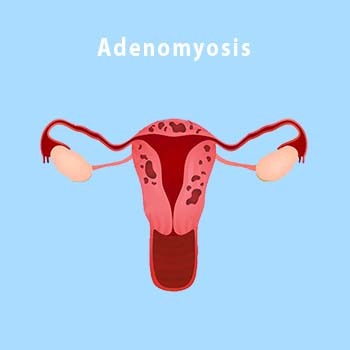ADENOMYOSIS
-
What is adenomyosis?
Adenomyosis is when tissue similar to the lining of your uterus (endometrium) starts to grow into the muscle wall of your uterus (myometrium). It causes our uterus to thicken and enlarge — sometimes, up to double or triple its usual size. Adenomyosis can cause painful periods, heavy or prolonged menstrual bleeding with clotting and abdominal/pelvic pain.
Many women aren’t aware they have adenomyosis because the condition doesn’t always cause symptoms. The exact prevalence of adenomyosis is unknown. However, researchers know it’s more common in people who:
Have had a procedure on their uterus.
Are older than 40.
-
Symptoms
About 1 in 3 people with adenomyosis don’t have signs or symptoms. Some people experience:
Painful menstrual cramps (dysmenorrhea).
Heavy menstrual bleeding (menorrhagia).
Abnormal menstruation.
Pelvic pain with or without severe cramping.
Painful intercourse (dyspareunia).
Infertility.
Enlarged uterus.
Bloating or fullness in your belly (adenomyosis belly).
-
Causes
Researchers don’t know why some people develop adenomyosis or what causes it. However, some research suggests hormones, genetics or inflammation/trauma may contribute to adenomyosis.
-
What are the risk factors for this condition?
Adenomyosis most commonly occurs in women and people AFAB who:
Are between the ages of 40 and 50.
Have given birth at least once.
Have had prior uterine surgeries such as uterine fibroid removal or dilation and curettage (D&C).
Have endometriosis.
However, providers are diagnosing adenomyosis more frequently in people in their 30s who have abnormal vaginal bleeding or painful periods.
-
Complications
The symptoms of adenomyosis tend to get worse over time. Heavy menstrual bleeding from adenomyosis increases your risk of anemia. Anemia may cause you to feel fatigued.
-
Diagnosis and Tests
Gynecologists often suspect adenomyosis based on your symptoms and one or more of these tests:
Risk factors for urge incontinence include:
Pelvic exam: During a pelvic exam, your provider may notice that your uterus has gotten larger, softer or is painful to the touch.
Ultrasound: A transvaginal ultrasound uses sound waves to produce images of your pelvic organs. These images can sometimes show thickening of your uterine wall.
Imaging scans: Magnetic resonance imaging (MRI) scans can show uterine enlargement and thickening of certain areas of your uterus.
Your gynecologist may rule out more serious conditions with a biopsy. During a biopsy, your gynecologist collects tissue and tests it for signs of more serious diseases.
-
How is adenomyosis managed or treated?
Because the hormone estrogen promotes endometrial tissue growth, adenomyosis symptoms often go away after menopause. In the meantime, these treatments can ease pain, and help with heavy bleeding and other symptoms:
Other signs of urge incontinence include:
Pain medications: Nonsteroidal anti-inflammatory drugs, or NSAIDs.
Hormonal medications: Certain hormonal medications can help with menstruation and abnormal bleeding. Options include birth control pills, and hormonal intrauterine devices (IUD), such as Mirena®.
Nonhormonal medication: Medications like tranexamic acid can reduce the amount of vaginal bleeding.
Adenomyomectomy: Surgery to remove adenomyosis from your uterine muscle. This procedure is similar to a myomectomy, which removes uterine fibroids.
Hysterectomy: This surgery removes your uterus.
Left untreated, adenomyosis can lead to infertility or miscarriage. This is because the embryo can’t implant into your uterine lining. Other problems may include chronic pelvic and abdominal pain.
-
How does adenomyosis affect pregnancy?
Adenomyosis tends to affect women who have had at least one child. However, the condition may make it difficult to conceive for the first time or to have another child. Once you’re pregnant, there’s an increased risk of:
Miscarriage.
Premature labor.
-
What is the difference between adenomyosis and endometriosis?
Adenomyosis and endometriosis are disorders that involve endometrial-like tissue. Both. conditions can be painful. Adenomyosis is more likely to cause heavy menstrual bleeding. The difference between these conditions is where the tissue grows.
Adenomyosis: Endometrial-like tissue grows into the muscle of your uterus.
Endometriosis: Endometrial-like tissue grows outside your uterus in places like your ovaries or fallopian tubes.
Management and Treatment

